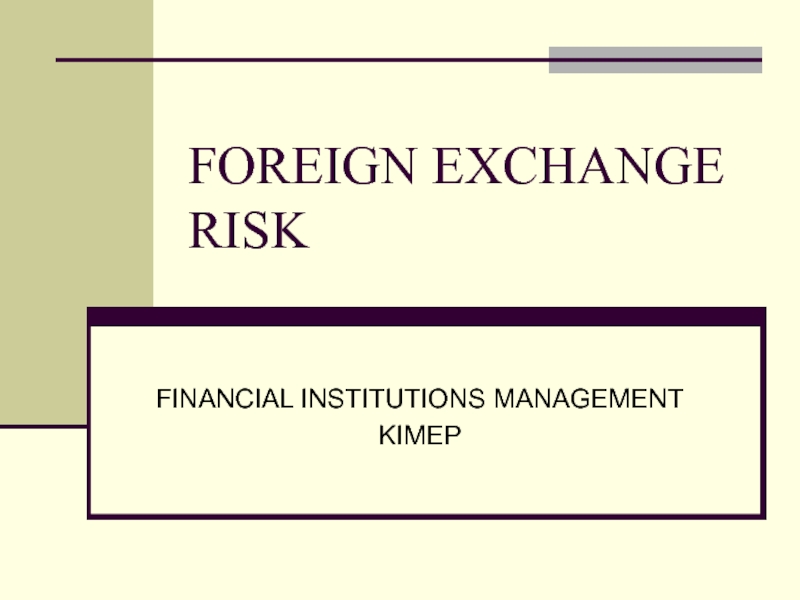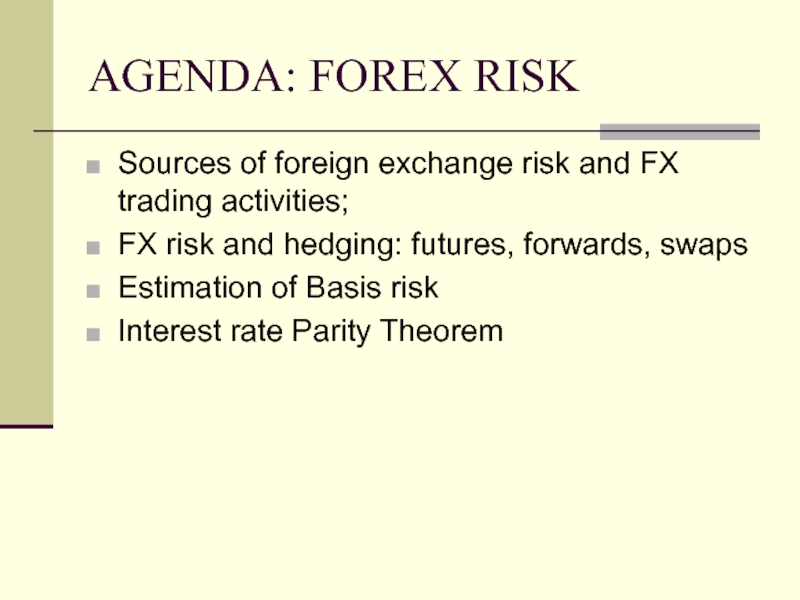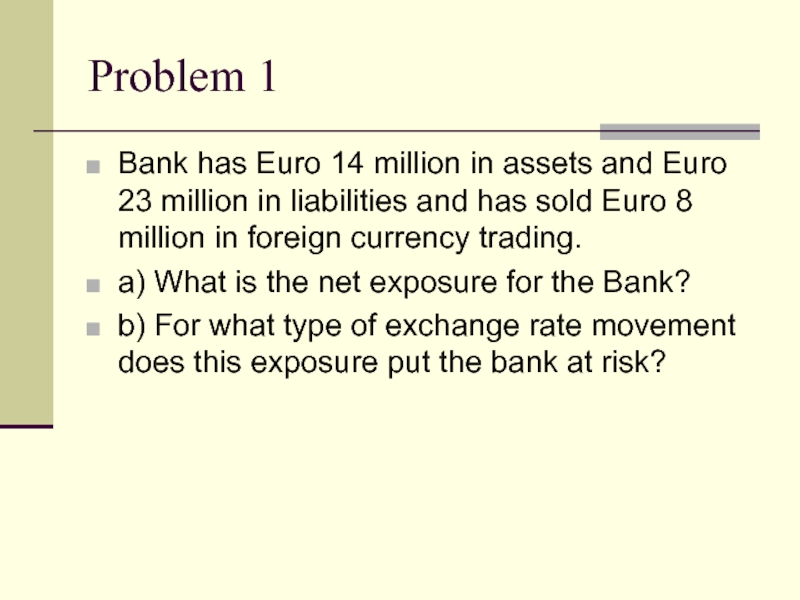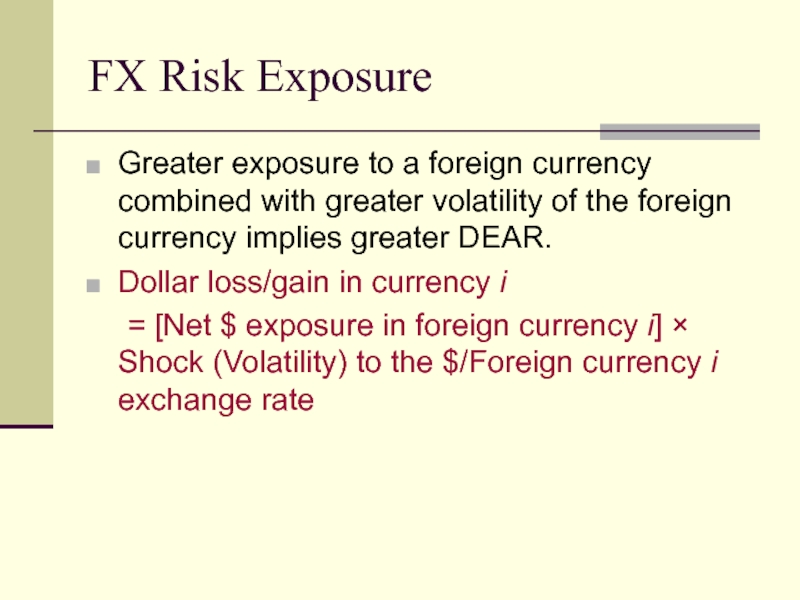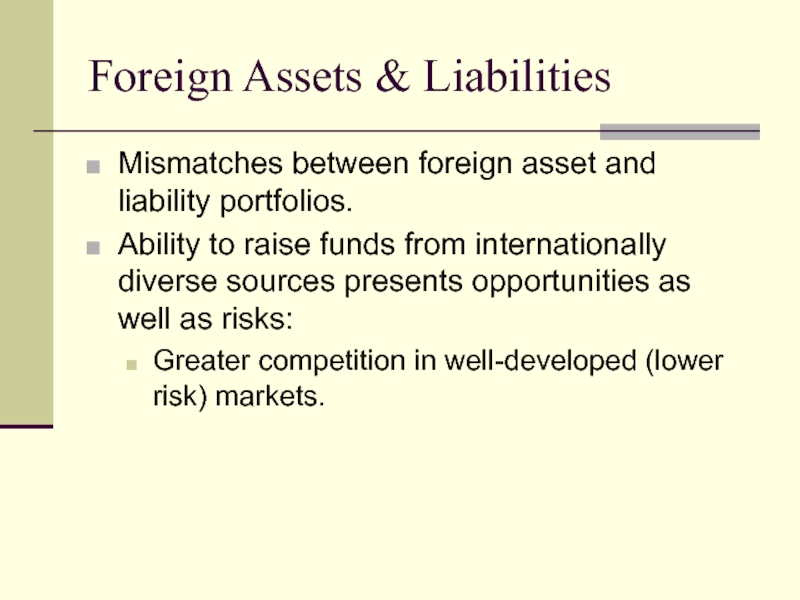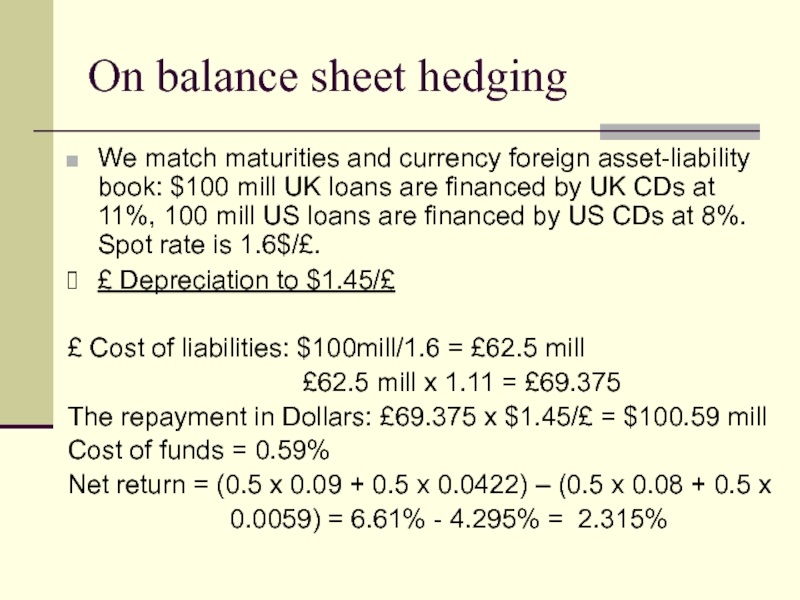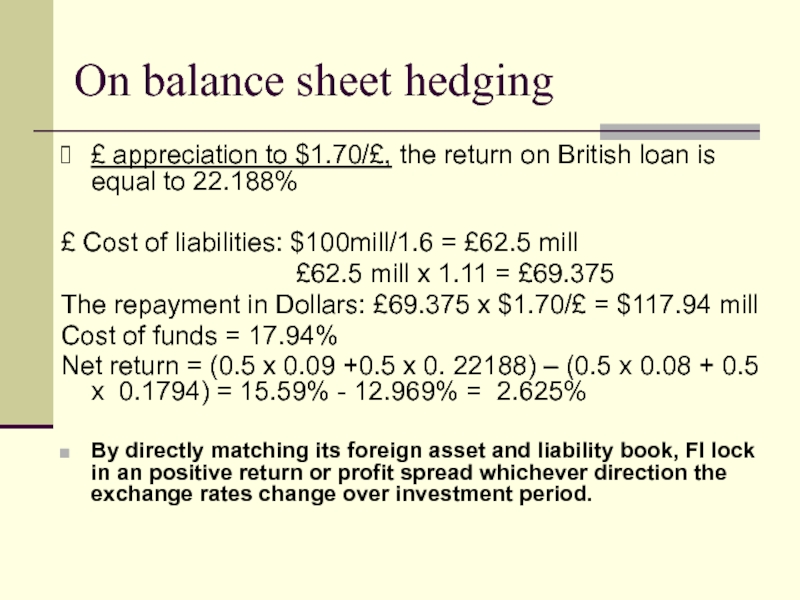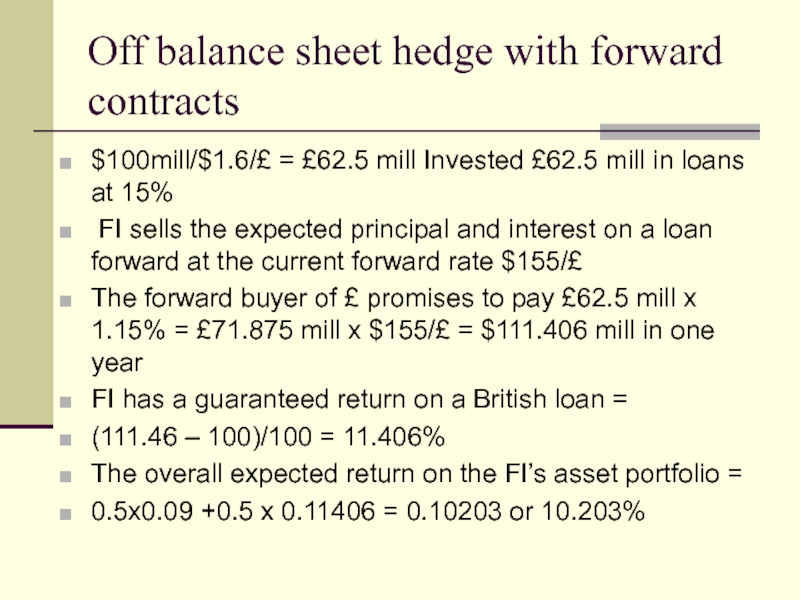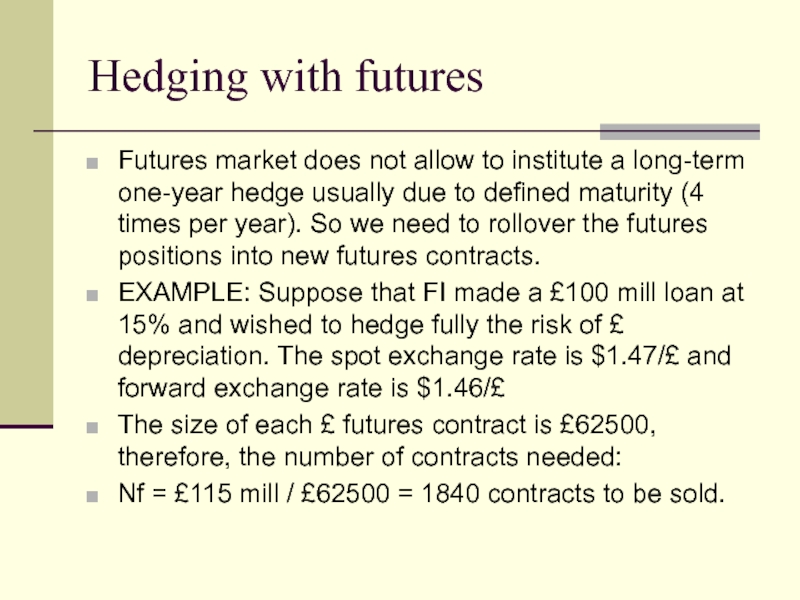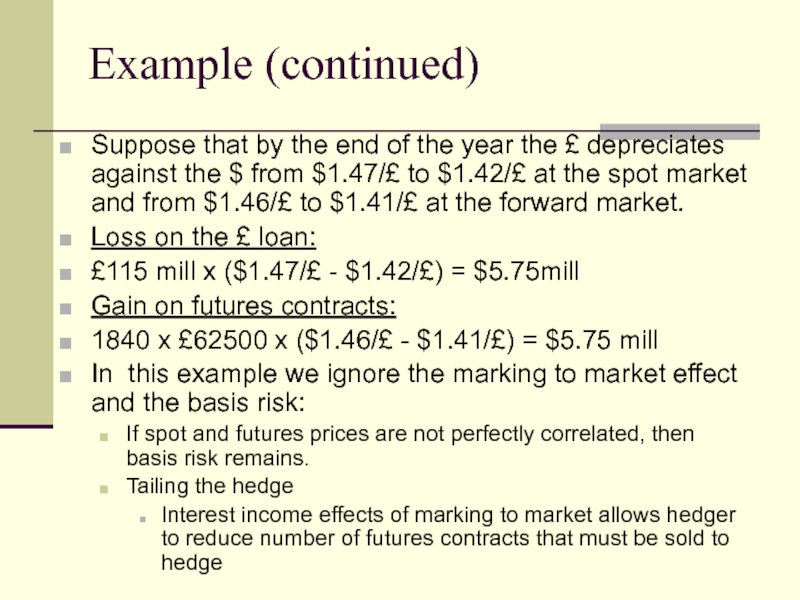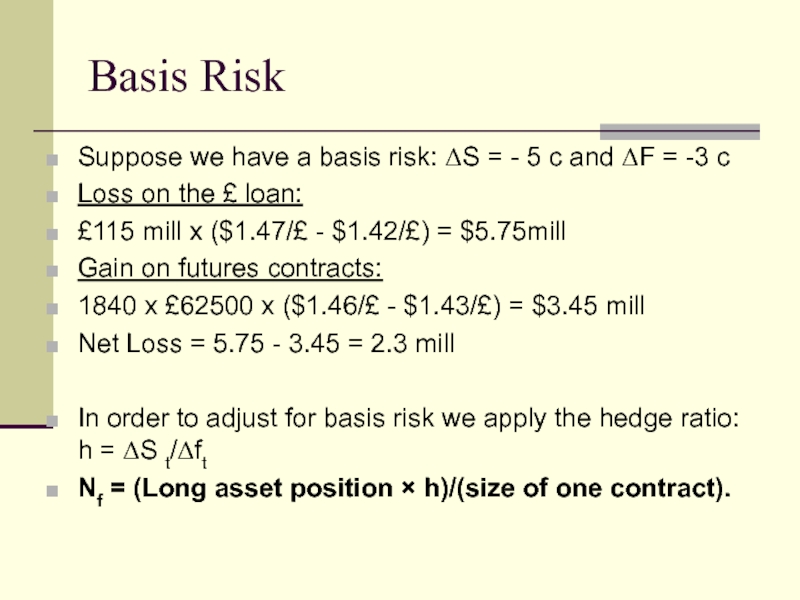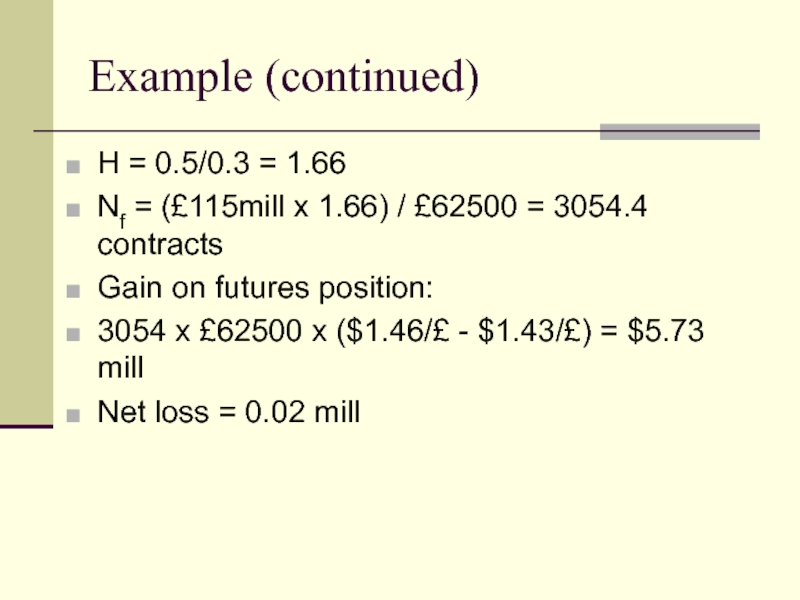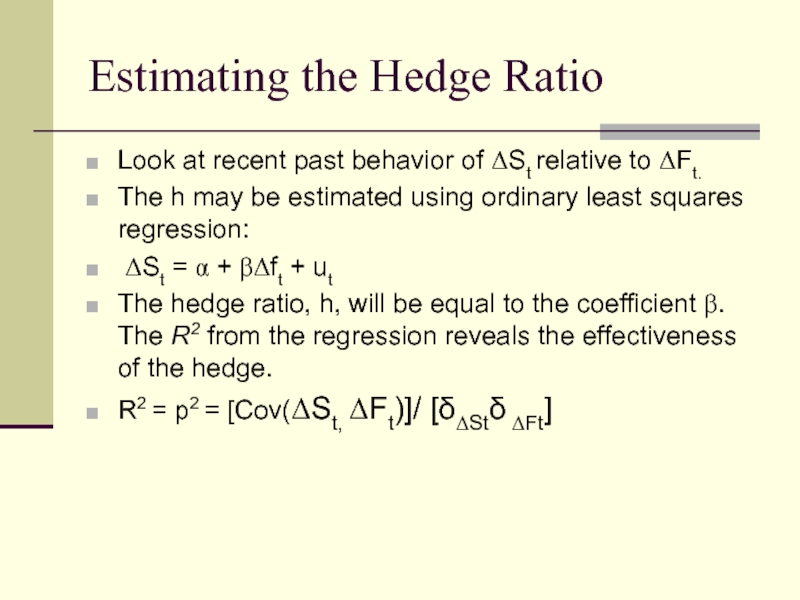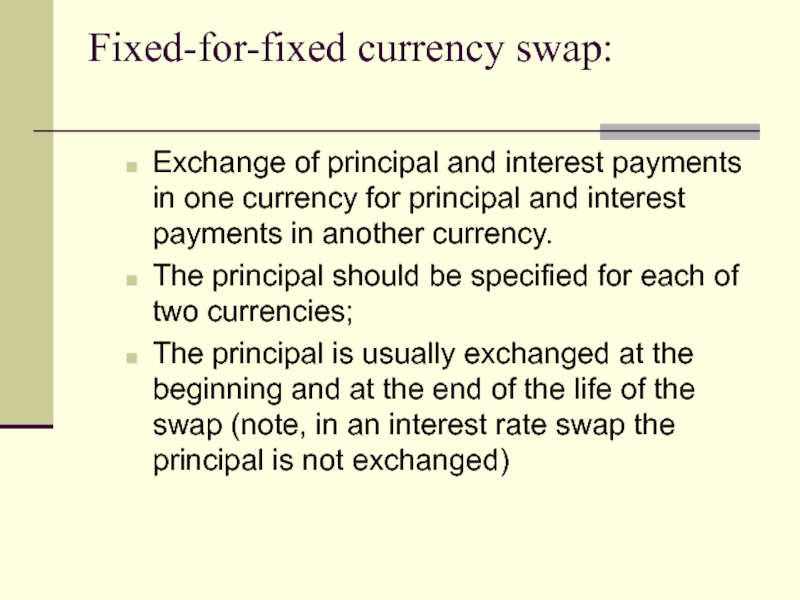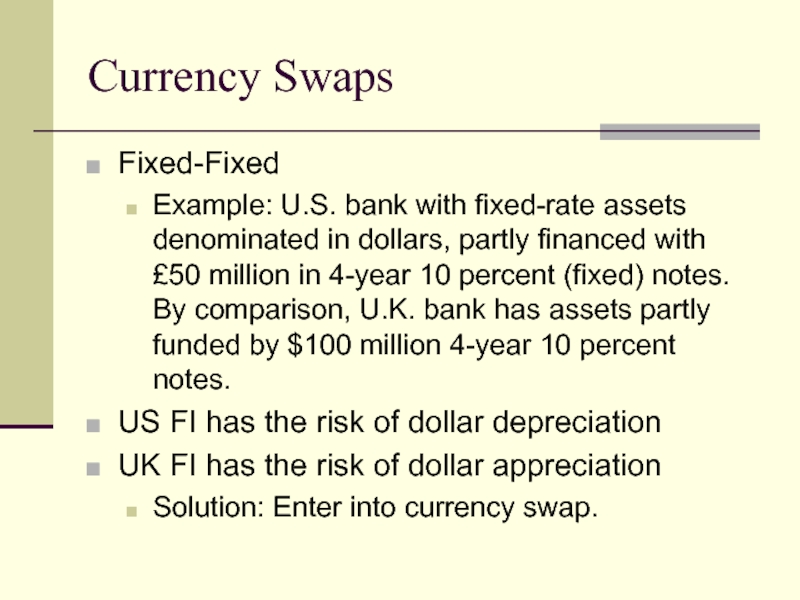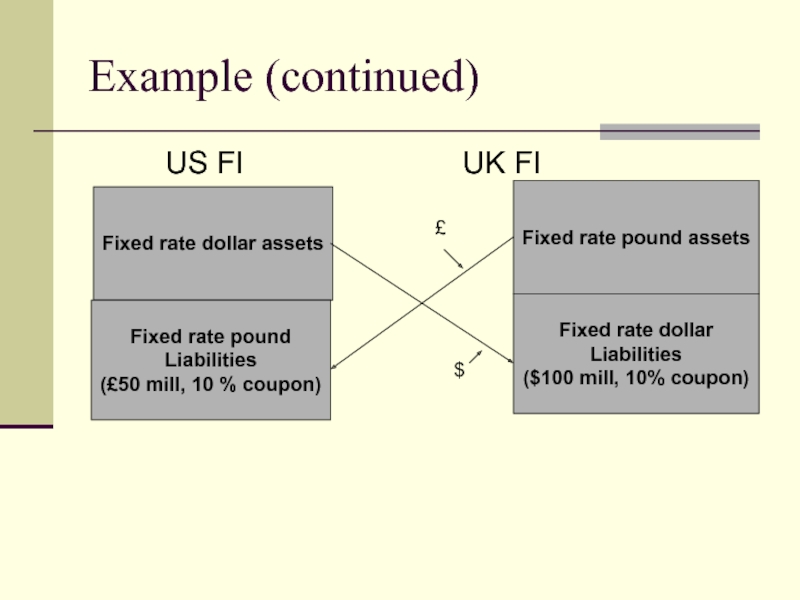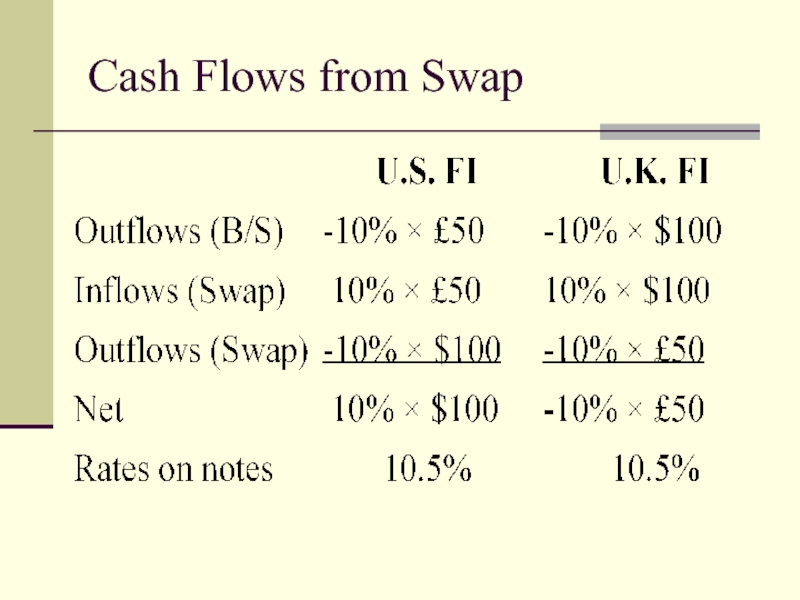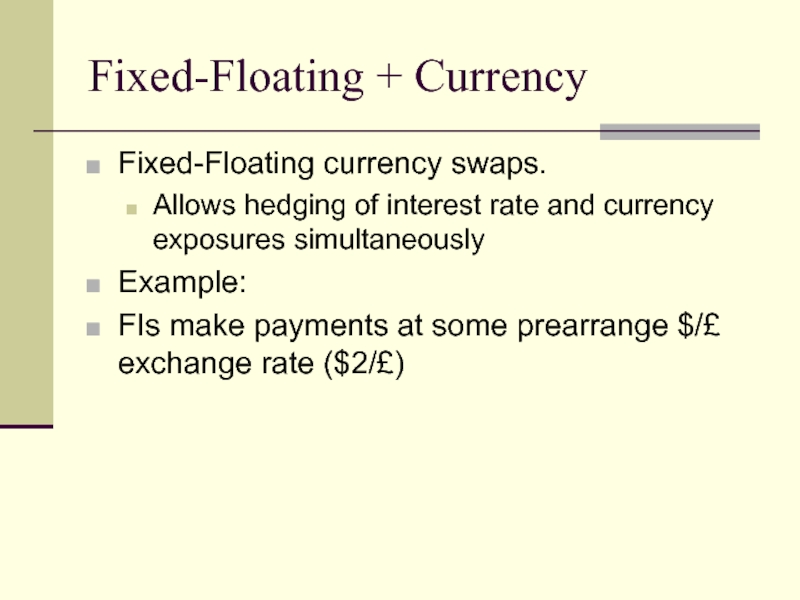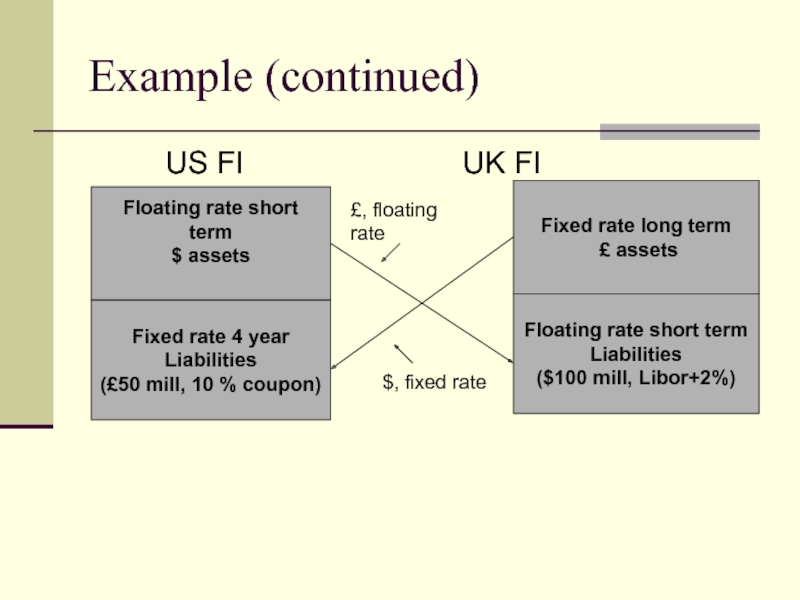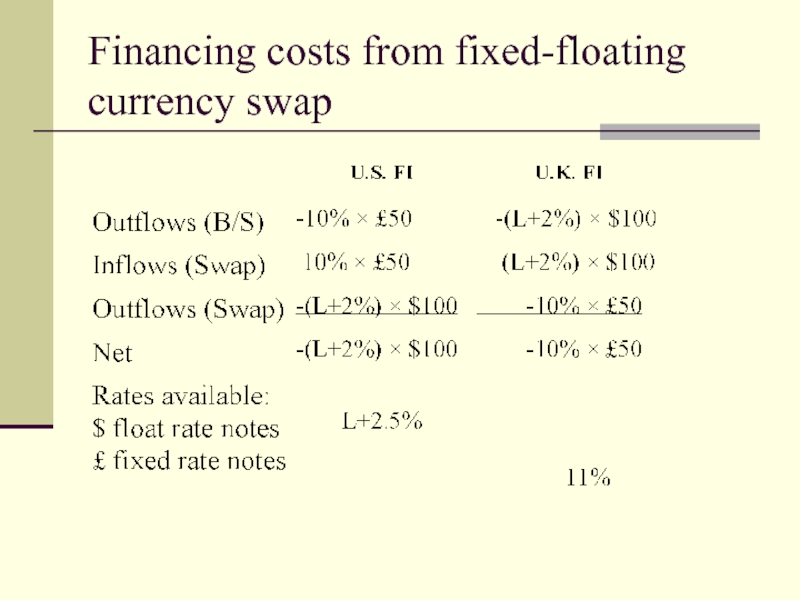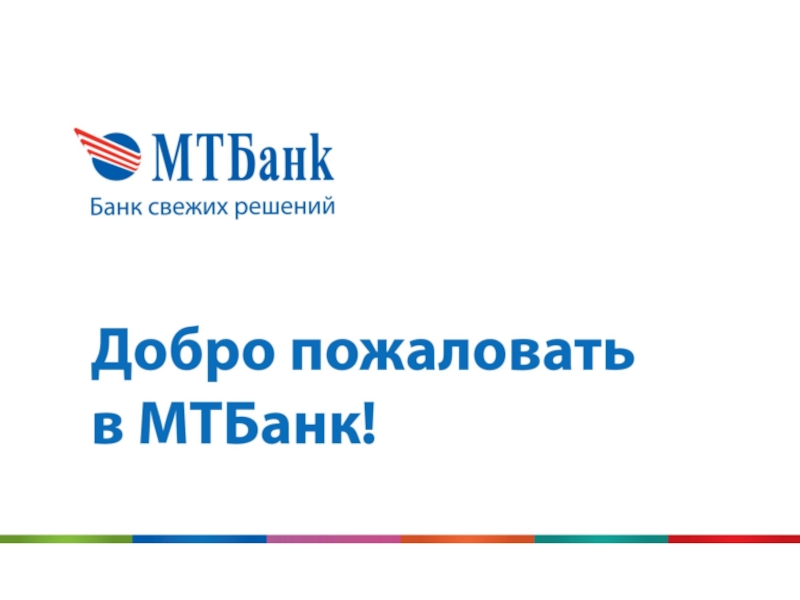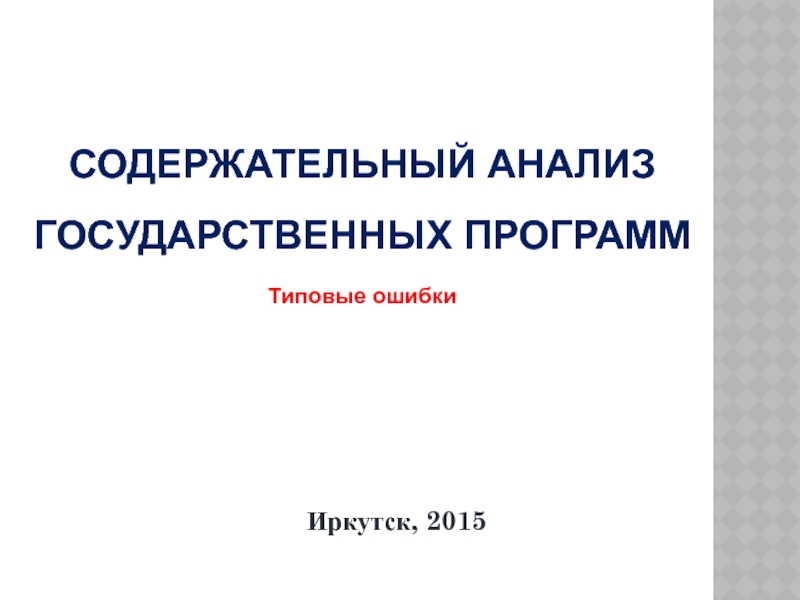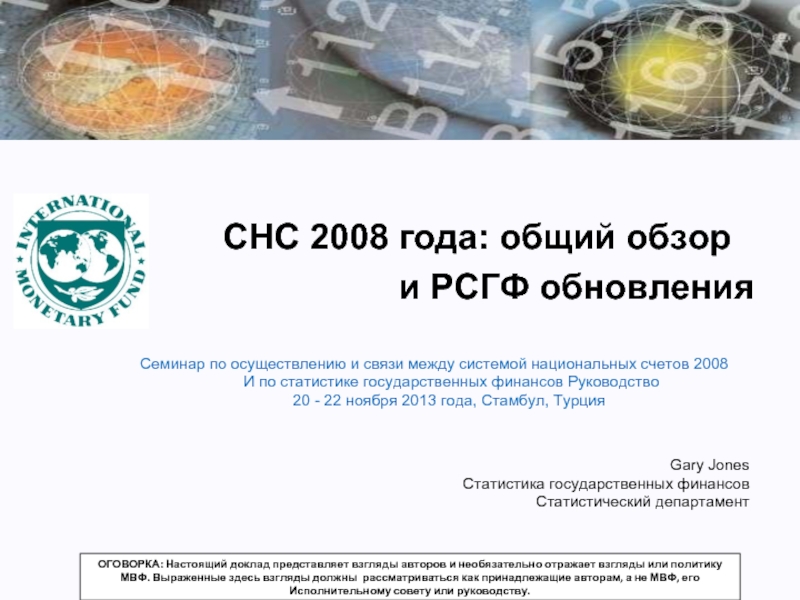- Главная
- Разное
- Дизайн
- Бизнес и предпринимательство
- Аналитика
- Образование
- Развлечения
- Красота и здоровье
- Финансы
- Государство
- Путешествия
- Спорт
- Недвижимость
- Армия
- Графика
- Культурология
- Еда и кулинария
- Лингвистика
- Английский язык
- Астрономия
- Алгебра
- Биология
- География
- Детские презентации
- Информатика
- История
- Литература
- Маркетинг
- Математика
- Медицина
- Менеджмент
- Музыка
- МХК
- Немецкий язык
- ОБЖ
- Обществознание
- Окружающий мир
- Педагогика
- Русский язык
- Технология
- Физика
- Философия
- Химия
- Шаблоны, картинки для презентаций
- Экология
- Экономика
- Юриспруденция
Foreign exchange risk презентация
Содержание
- 1. Foreign exchange risk
- 2. AGENDA: FOREX RISK Sources of foreign exchange
- 3. Sources of FX Risk Spot positions denominated
- 4. Problem 1 Bank has Euro 14 million
- 5. FX Risk Exposure Greater exposure to a
- 6. Trading Activities Basically 4 trading activities: Purchase
- 7. Foreign Assets & Liabilities Mismatches between
- 8. Return and Risk of Foreign Investments
- 9. EXAMPLE: FI issued $200 mill one-year CDs
- 10. Risk and Hedging Hedge can be constructed
- 11. On balance sheet hedging We match maturities
- 12. £ appreciation to $1.70/£, the
- 13. Off balance sheet hedge with forward contracts
- 14. Specifications of the FX futures Six months
- 15. Hedging with futures. What is your risk
- 16. Hedging with futures Should you take long
- 17. Hedging with futures Futures market does not
- 18. Example (continued) Suppose that by the end
- 19. Basis Risk Suppose we have a basis
- 20. Example (continued) H = 0.5/0.3 = 1.66
- 21. Estimating the Hedge Ratio Look at recent
- 22. Fixed-for-fixed currency swap: Exchange of
- 23. Currency Swaps Fixed-Fixed Example: U.S. bank
- 24. Example (continued)
- 25. Cash Flows from Swap
- 26. Fixed-Floating + Currency Fixed-Floating currency swaps. Allows
- 27. Example (continued)
- 28. Financing costs from fixed-floating currency swap
Слайд 2AGENDA: FOREX RISK
Sources of foreign exchange risk and FX trading activities;
FX
Estimation of Basis risk
Interest rate Parity Theorem
Слайд 3Sources of FX Risk
Spot positions denominated in foreign currency
Forward positions denominated
Net exposure = (FX assets - FX liabilities) + (FX bought - FX sold)
Net long position in currency = FI bought more currency than it has sold or have more FX assets than liabilities.
Net short position in currency = FI has sold more foreign currency that it has purchased or have more FX liabilities than assets.
Слайд 4Problem 1
Bank has Euro 14 million in assets and Euro 23
a) What is the net exposure for the Bank?
b) For what type of exchange rate movement does this exposure put the bank at risk?
Слайд 5FX Risk Exposure
Greater exposure to a foreign currency combined with greater
Dollar loss/gain in currency i
= [Net $ exposure in foreign currency i] × Shock (Volatility) to the $/Foreign currency i exchange rate
Слайд 6Trading Activities
Basically 4 trading activities:
Purchase and sale of currencies to complete
Facilitating positions in foreign real and financial investments.
Accommodating hedging activities.
Speculation.
Слайд 7Foreign Assets & Liabilities
Mismatches between foreign asset and liability portfolios.
Ability
Greater competition in well-developed (lower risk) markets.
Слайд 8Return and Risk of
Foreign Investments
Returns are affected by:
Spread between costs
Changes in FX rates
Changes in FX rates are not under the control of the FI
Слайд 9EXAMPLE: FI issued $200 mill one-year CDs at 8% and invested
$100mill/1.6 = £62.5 mill
Invest £62.5 mill in loans at 15%
The revenue by the end of the year = £62.5 mill x 1.15% = £71.875 mill
Suppose that the spot exchange rate has fallen in value from $1.6/£ to $1.45/£ next year, hence
£71.875 mill x $1.45/£ = $104.22 mill.
Return on the investments is 4.22%
The weighted return on the FI’s asset portfolio =
0.5x0.09 +0.5 x 0.0422 = 0.0661 or 6.61% that is less than the cost of funds 8%
Слайд 10Risk and Hedging
Hedge can be constructed on balance sheet or off
On - balance-sheet hedge requires duration matching and currency matching.
Off-balance-sheet hedge involves forwards, futures, options or swaps.
No balance sheet rebalancing;
No immediate cash flow only future contingent cash flow;
Lower costs and administration.
BUT, we have a default risk of counterparty.
Слайд 11On balance sheet hedging
We match maturities and currency foreign asset-liability book:
£ Depreciation to $1.45/£
£ Cost of liabilities: $100mill/1.6 = £62.5 mill
£62.5 mill x 1.11 = £69.375
The repayment in Dollars: £69.375 x $1.45/£ = $100.59 mill
Cost of funds = 0.59%
Net return = (0.5 x 0.09 + 0.5 x 0.0422) – (0.5 x 0.08 + 0.5 x
0.0059) = 6.61% - 4.295% = 2.315%
Слайд 12
£ appreciation to $1.70/£, the return on British loan is
£ Cost of liabilities: $100mill/1.6 = £62.5 mill
£62.5 mill x 1.11 = £69.375
The repayment in Dollars: £69.375 x $1.70/£ = $117.94 mill
Cost of funds = 17.94%
Net return = (0.5 x 0.09 +0.5 x 0. 22188) – (0.5 x 0.08 + 0.5 x 0.1794) = 15.59% - 12.969% = 2.625%
By directly matching its foreign asset and liability book, FI lock in an positive return or profit spread whichever direction the exchange rates change over investment period.
On balance sheet hedging
Слайд 13Off balance sheet hedge with forward contracts
$100mill/$1.6/£ = £62.5 mill Invested
FI sells the expected principal and interest on a loan forward at the current forward rate $155/£
The forward buyer of £ promises to pay £62.5 mill x 1.15% = £71.875 mill x $155/£ = $111.406 mill in one year
FI has a guaranteed return on a British loan =
(111.46 – 100)/100 = 11.406%
The overall expected return on the FI’s asset portfolio =
0.5x0.09 +0.5 x 0.11406 = 0.10203 or 10.203%
Слайд 14Specifications of the FX futures
Six months in the March quarterly cycle
Physical delivery
Last trading day: 9:16 a.m. Central Time (CT) on the second business day immediately preceding the third Wednesday of the contract month (usually Monday).
Слайд 15Hedging with futures.
What is your risk if you have a long
Foreign currency appreciation
Foreign currency depreciation
Слайд 16Hedging with futures
Should you take long or short position in FX
you are planning to sell Foreign currency in the future;
You want to hedge the portfolio of foreign stocks against the foreign exchange risk;
You are planning to borrow a syndicated loan from a foreign bank;
You are planning to buy foreign bonds in 2 months.
Liabilities in foreign currency exceed the assets in foreign currency.
Слайд 17Hedging with futures
Futures market does not allow to institute a long-term
EXAMPLE: Suppose that FI made a £100 mill loan at 15% and wished to hedge fully the risk of £ depreciation. The spot exchange rate is $1.47/£ and forward exchange rate is $1.46/£
The size of each £ futures contract is £62500, therefore, the number of contracts needed:
Nf = £115 mill / £62500 = 1840 contracts to be sold.
Слайд 18Example (continued)
Suppose that by the end of the year the £
Loss on the £ loan:
£115 mill x ($1.47/£ - $1.42/£) = $5.75mill
Gain on futures contracts:
1840 x £62500 x ($1.46/£ - $1.41/£) = $5.75 mill
In this example we ignore the marking to market effect and the basis risk:
If spot and futures prices are not perfectly correlated, then basis risk remains.
Tailing the hedge
Interest income effects of marking to market allows hedger to reduce number of futures contracts that must be sold to hedge
Слайд 19Basis Risk
Suppose we have a basis risk: ΔS = - 5
Loss on the £ loan:
£115 mill x ($1.47/£ - $1.42/£) = $5.75mill
Gain on futures contracts:
1840 x £62500 x ($1.46/£ - $1.43/£) = $3.45 mill
Net Loss = 5.75 - 3.45 = 2.3 mill
In order to adjust for basis risk we apply the hedge ratio: h = ΔS t/Δft
Nf = (Long asset position × h)/(size of one contract).
Слайд 20Example (continued)
H = 0.5/0.3 = 1.66
Nf = (£115mill x 1.66)
Gain on futures position:
3054 x £62500 x ($1.46/£ - $1.43/£) = $5.73 mill
Net loss = 0.02 mill
Слайд 21Estimating the Hedge Ratio
Look at recent past behavior of ΔSt relative
The h may be estimated using ordinary least squares regression:
ΔSt = α + βΔft + ut
The hedge ratio, h, will be equal to the coefficient β. The R2 from the regression reveals the effectiveness of the hedge.
R2 = p2 = [Cov(ΔSt, ΔFt)]/ [δΔStδ ΔFt]
Слайд 22Fixed-for-fixed currency swap:
Exchange of principal and interest payments in one
The principal should be specified for each of two currencies;
The principal is usually exchanged at the beginning and at the end of the life of the swap (note, in an interest rate swap the principal is not exchanged)
Слайд 23Currency Swaps
Fixed-Fixed
Example: U.S. bank with fixed-rate assets denominated in dollars,
US FI has the risk of dollar depreciation
UK FI has the risk of dollar appreciation
Solution: Enter into currency swap.
Слайд 24Example (continued)
US FI
Fixed rate dollar assets
Fixed rate pound
Liabilities
(£50 mill, 10 % coupon)
Fixed rate pound assets
Fixed rate dollar
Liabilities
($100 mill, 10% coupon)
£
$
Слайд 26Fixed-Floating + Currency
Fixed-Floating currency swaps.
Allows hedging of interest rate and currency
Example:
FIs make payments at some prearrange $/£ exchange rate ($2/£)
Слайд 27Example (continued)
US FI
Floating rate short term
$ assets
Fixed rate 4 year
Liabilities
(£50 mill, 10 % coupon)
Fixed rate long term
£ assets
Floating rate short term
Liabilities
($100 mill, Libor+2%)
£, floating rate
$, fixed rate
